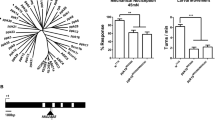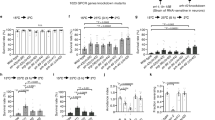Abstract
Touch sensation is essential for behaviours ranging from environmental exploration to social interaction; however, the underlying mechanisms are largely unknown1. In Drosophila larvae, two types of sensory neurons, class III and class IV dendritic arborization neurons, tile the body wall. The mechanotransduction channel PIEZO in class IV neurons is essential for sensing noxious mechanical stimuli but is not involved in gentle touch2. On the basis of electrophysiological-recording, calcium-imaging and behavioural studies, here we report that class III dendritic arborization neurons are touch sensitive and contribute to gentle-touch sensation. We further identify NOMPC (No mechanoreceptor potential C), a member of the transient receptor potential (TRP) family of ion channels, as a mechanotransduction channel for gentle touch. NOMPC is highly expressed in class III neurons and is required for their mechanotransduction. Moreover, ectopic NOMPC expression confers touch sensitivity to the normally touch-insensitive class IV neurons. In addition to the critical role of NOMPC in eliciting gentle-touch-mediated behavioural responses, expression of this protein in the Drosophila S2 cell line also gives rise to mechanosensitive channels in which ion selectivity can be altered by NOMPC mutation, indicating that NOMPC is a pore-forming subunit of a mechanotransduction channel. Our study establishes NOMPC as a bona fide mechanotransduction channel that satisfies all four criteria proposed for a channel to qualify as a transducer of mechanical stimuli3 and mediates gentle-touch sensation. Our study also suggests that different mechanosensitive channels may be used to sense gentle touch versus noxious mechanical stimuli.
This is a preview of subscription content, access via your institution
Access options
Subscribe to this journal
Receive 51 print issues and online access
$199.00 per year
only $3.90 per issue
Buy this article
- Purchase on Springer Link
- Instant access to full article PDF
Prices may be subject to local taxes which are calculated during checkout




Similar content being viewed by others
References
Lumpkin, E. A., Marshall, K. L. & Nelson, A. M. The cell biology of touch. J. Cell Biol. 191, 237–248 (2010)
Kim, S. E., Coste, B., Chadha, A., Cook, B. & Patapoutian, A. The role of Drosophila Piezo in mechanical nociception. Nature 483, 209–212 (2012)
Árnadóttir, J. & Chalfie, M. Eukaryotic mechanosensitive channels. Annu. Rev. Biophys. 39, 111–137 (2010)
Gong, Z. et al. Two interdependent TRPV channel subunits, inactive and Nanchung, mediate hearing in Drosophila. J. Neurosci. 24, 9059–9066 (2004)
Caldwell, J. C. & Eberl, D. F. Towards a molecular understanding of Drosophila hearing. J. Neurobiol. 53, 172–189 (2002)
Kamikouchi, A. et al. The neural basis of Drosophila gravity-sensing and hearing. Nature 458, 165–171 (2009)
Hughes, C. L. & Thomas, J. B. A sensory feedback circuit coordinates muscle activity in Drosophila. Mol. Cell. Neurosci. 35, 383–396 (2007)
Tracey, W. D., Jr, Wilson, R. I., Laurent, G. & Benzer, S. painless, a Drosophila gene essential for nociception. Cell 113, 261–273 (2003)
Yorozu, S. et al. Distinct sensory representations of wind and near-field sound in the Drosophila brain. Nature 458, 201–205 (2009)
Liang, X., Madrid, J., Saleh, H. S. & Howard, J. NOMPC, a member of the TRP channel family, localizes to the tubular body and distal cilium of Drosophila campaniform and chordotonal receptor cells. Cytoskeleton 68, 1–7 (2011)
Song, W., Onishi, M., Jan, L. Y. & Jan, Y. N. Peripheral multidendritic sensory neurons are necessary for rhythmic locomotion behavior in Drosophila larvae. Proc. Natl Acad. Sci. USA 104, 5199–5204 (2007)
Kernan, M., Cowan, D. & Zuker, C. Genetic dissection of mechanosensory transduction: mechanoreception-defective mutations of Drosophila. Neuron 12, 1195–1206 (1994)
Grueber, W. B., Jan, L. Y. & Jan, Y. N. Tiling of the Drosophila epidermis by multidendritic sensory neurons. Development 129, 2867–2878 (2002)
Zhong, L., Hwang, R. Y. & Tracey, W. D. Pickpocket is a DEG/ENaC protein required for mechanical nociception in Drosophila larvae. Curr. Biol. 20, 429–434 (2010)
Geffeney, S. L. & Goodman, M. B. How we feel: ion channel partnerships that detect mechanical inputs and give rise to touch and pain perception. Neuron 74, 609–619 (2012)
Li, L. et al. The functional organization of cutaneous low-threshold mechanosensory neurons. Cell 147, 1615–1627 (2011)
Delmas, P., Hao, J. & Rodat-Despoix, L. Molecular mechanisms of mechanotransduction in mammalian sensory neurons. Nature Rev. Neurosci. 12, 139–153 (2011)
Cheng, L. E., Song, W., Looger, L. L., Jan, L. Y. & Jan, Y. N. The role of the TRP channel NompC in Drosophila larval and adult locomotion. Neuron 67, 373–380 (2010)
Effertz, T., Wiek, R. & Gopfert, M. C. NompC TRP channel is essential for Drosophila sound receptor function. Curr. Biol. 21, 592–597 (2011)
Eberl, D. F., Hardy, R. W. & Kernan, M. J. Genetically similar transduction mechanisms for touch and hearing in Drosophila. J. Neurosci. 20, 5981–5988 (2000)
Walker, R. G., Willingham, A. T. & Zuker, C. S. A Drosophila mechanosensory transduction channel. Science 287, 2229–2234 (2000)
Lee, J., Moon, S., Cha, Y. & Chung, Y. D. Drosophila TRPN( = NOMPC) channel localizes to the distal end of mechanosensory cilia. PLoS ONE 5, e11012 (2010)
Kang, L., Gao, J., Schafer, W. R., Xie, Z. & Xu, X. Z. C. elegans TRP family protein TRP-4 is a pore-forming subunit of a native mechanotransduction channel. Neuron 67, 381–391 (2010)
Meyers, J. R. et al. Lighting up the senses: FM1-43 loading of sensory cells through nonselective ion channels. J. Neurosci. 23, 4054–4065 (2003)
Moran, M. M., Xu, H. & Clapham, D. E. TRP ion channels in the nervous system. Curr. Opin. Neurobiol. 14, 362–369 (2004)
Venkatachalam, K. & Montell, C. TRP channels. Annu. Rev. Biochem. 76, 387–417 (2007)
Christensen, A. P. & Corey, D. P. TRP channels in mechanosensation: direct or indirect activation? Nature Rev. Neurosci. 8, 510–521 (2007)
Coste, B. et al. Piezo proteins are pore-forming subunits of mechanically activated channels. Nature 483, 176–181 (2012)
Xiang, Y. et al. Light-avoidance-mediating photoreceptors tile the Drosophila larval body wall. Nature 468, 921–926 (2010)
Rumpf, S., Lee, S. B., Jan, L. Y. & Jan, Y. N. Neuronal remodeling and apoptosis require VCP-dependent degradation of the apoptosis inhibitor DIAP1. Development 138, 1153–1160 (2011)
Acknowledgements
We thank C. Zuker, U. Heberlein, G. Rubin, T. Lee and R. Bodmer for fly lines, J. Howard for the NOMPC antibody and L. Looger for GCaMP5. We thank D. Minor and S. Bagriantsev for assistance with the high-speed pressure clamp. We thank S. Younger, S. Barbel and T. Cheng for technical support, W. P. Ge, M. P. Klassen, P. Fan, E. K. Unger and C. J. Peters for reading the manuscript, and members of the Jan laboratory for discussion. Z.Y. and Y.X. are recipients of the Long-Term Fellowship from the Human Frontier Science Program. This work was supported by National Institutes of Health grants (R37NS040929 and 5R01MH084234) to Y.N.J. L.Y.J. and Y.N.J. are investigators of the Howard Hughes Medical Institute.
Author information
Authors and Affiliations
Contributions
Z.Y. and W.Z. initiated the project, designed and conducted most experiments; Y.N.J. and L.Y.J. supervised the project and provided guidance throughout. L.E.C. and W.Z. made the NOMPC mutants. Y.H., Y.X. and S.M. assisted with part of the behavioural experiments and immunostaining. D.G. helped set up the piezo actuator system. Z.Y., W.Z., L.Y.J. and Y.N.J. wrote the manuscript. All authors discussed the results and commented on the manuscript.
Corresponding author
Ethics declarations
Competing interests
The authors declare no competing financial interests.
Supplementary information
Supplementary Information
This file contains Supplementary Figures 1-17, Supplementary Methods and additional references. (PDF 1508 kb)
Rights and permissions
About this article
Cite this article
Yan, Z., Zhang, W., He, Y. et al. Drosophila NOMPC is a mechanotransduction channel subunit for gentle-touch sensation. Nature 493, 221–225 (2013). https://doi.org/10.1038/nature11685
Received:
Accepted:
Published:
Issue Date:
DOI: https://doi.org/10.1038/nature11685
This article is cited by
-
Drosophila TMEM63 and mouse TMEM63A are lysosomal mechanosensory ion channels
Nature Cell Biology (2024)
-
Glia instruct axon regeneration via a ternary modulation of neuronal calcium channels in Drosophila
Nature Communications (2023)
-
Humidity response in Drosophila olfactory sensory neurons requires the mechanosensitive channel TMEM63
Nature Communications (2022)
-
A small molecule screen identifies novel inhibitors of mechanosensory nematocyst discharge in Hydra
Scientific Reports (2021)
-
The Atr-Chek1 pathway inhibits axon regeneration in response to Piezo-dependent mechanosensation
Nature Communications (2021)
Comments
By submitting a comment you agree to abide by our Terms and Community Guidelines. If you find something abusive or that does not comply with our terms or guidelines please flag it as inappropriate.



